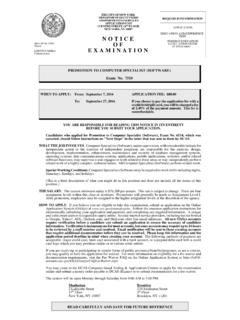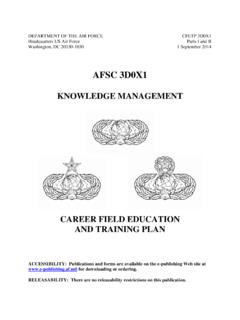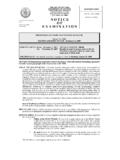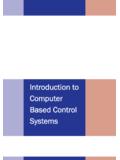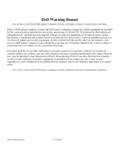Transcription of Digital Equipment Corporation - memex.org
1 61In Memoriam: J. C. R. Licklider1915-1990 August 7, 1990 Systems Research Center130 Lytton AvenuePalo Alto, California 94301 Systems Research CenterThe charter of SRC is to advance both the state of knowledge and the stateof the art in computer our establishment in 1984, we haveperformed basic and applied research to support Digital s business objec-tives, Our current work includes exploring distributed personal computingon multiple platforms, networking, programming technology, system mod-elling and management techniques, and selected strategy is to test the technical and practical value of our ideas bybuilding hardware and software prototypes and using them as daily systems are too complex to be evaluated solely in the abstract;extended use allows us to investigate their properties in depth.
2 This ex-perience is useful in the short term in refining our designs, and invaluablein the long term in advancing our knowledge. Most of the major advancesin information systems have come through this strategy, including personalcomputing, distributed systems, and the also perform complementary work of a more mathematical flavor. Someof it is in established fields of theoretical computer science, such as theanalysis of algorithms, computational geometry, and logics of work explores new ground motivated by problems that arise in oursystems have a strong commitment to communicating our results; exposing andtesting our ideas in the research and development communities leads to im-proved understanding.
3 Our research report series supplements publicationin professional journals and seek users for our prototypesystems among those with whom we have common interests, and we encour-age collaboration with university W. Taylor, DirectorIn Memoriam:J. C. R. Licklider1915 1990 IRE (now IEEE) 1960 Man- computer Symbiosis is reprinted, with permission, from IRE Trans-actions on Human Factors in Electronics, volume HFE-1, pages 4 11, March1960. Science and Technology 1968 The computer as a Communication Device is reprinted from Science andTechnology, April 1968. Digital Equipment Corporation 1990 This work may not be copied or reproduced in whole or in part for any com-mercial to copy in whole or in part without paymentof fee is granted for nonprofit educational and research purposes providedthat all such whole or partial copies include the following: a notice thatsuch copying is by permission of the Systems Research Center of DigitalEquipment Corporation in Palo Alto, California; an acknowledgment of theauthors and individual contributors to the work; and all applicable portionsof the copyright notice.
4 Copying, reproducing, or republishing for any otherpurpose shall require a license with payment of fee to the Systems ResearchCenter. All rights report honors J. C. R. Licklider for his contributions to computer sci-ence research and education in this country. We reprint here two of hispapers, originally published in the 1960s, which exemplify his ideas abouthow computers could enhance human you were ever fortunate enough to meet him, and you said somethinglike, It s nice to meet you, Dr. Licklider, he would ask right away thatyou please call him was Lick to friends, colleagues, and casualacquaintances had a vision of a better way of computing.
5 Once upon a time, toget a computer to do your bidding, you had to punch holes in paper cardsor tapes, give the paper to someone who fed it to the machine, and then goaway for hours or believed we could do better and, more thanany other single individual, saw to it that we the paper entitled Man- computer Symbiosis, published thirty yearsago, Lick provided a guide for decades of computer research to follow. Thepaper was based on work performed by a small research group organizedand headed by him at Bolt, Beranek, and Newman. In the late 1950s, thegroup purchased the first PDP- 1 from Digital . On this machine, Lick s groupdesigned and built one of the earliest time-sharing 1962, Lick was asked by the Director of the Advanced ResearchProjects Agency (ARPA) to join the agency to create and manage a programfor funding research.
6 Although its annual budget was greater than the totalamount of money allocated to computer research by all other government-supported agencies, it was one of the smaller programs within ARPA. Thisprogram led the way to commercial time-sharing in the late 60s and tonetworking in the computer establishment criticized Lick s ARPA program. Mostcomputer manufacturers and directors of computer centers argued that time-sharing was an inefficient use of machine resources and should not be pur-sued. But Lick had the courage to ARPA responsibilities included selecting and funding researchers tobuild and lead research groups.
7 In this connection, Lick was the architect ofProject MAC at MIT and a number of other projects that shaped the leaders he chose twenty-five years ago now read like a Who s Who ofcomputing least known of Lick s accomplishments is perhaps his most signif-icant. Prior to his work at ARPA, no university granted a incomputer science. A university graduate program requires a research base,and that in turn requires a long-term commitment of dollars. Lick s ARPA program set the precedent for providing the research base at four of thefirst universities to establish graduate programs in computer science: , CMU, MIT, and Stanford.
8 These programs, started in 1965, haveremained the country s strongest and have served as role models for otherdepartments that followed. Their success would have been impossible with-out the foundation put in place by Lick in all his considerable influence on computing, Lick retained his mod-esty. He was the most unlikely great man you could ever encounter. Hisfavorite kind of joke was one at his own expense. He was gentle, curious,and s vision provided an extremely fruitful, long-term direction for com-puting research. He guided the initial research funding that was necessaryto fulfil the early promises of the vision.
9 And he laid the foundation forgraduate education in the newly created field of computer science. All usersof interactive computing and every company that employs computer peopleowe him a great W. TaylorContentsMan- computer LickliderThe computer as a Communication Licklider and Robert W. Taylor121 Man- computer SymbiosisSummaryMan- computer symbiosis is an expected development in cooperative inter-action between men and electronic computers. It will involve very closecoupling between the human and the electronic members of the partner-ship. The main aims are 1) to let computers facilitate formulative thinkingas they now facilitate the solution of formulated problems, and 2) to enablemen and computers to cooperate in making decisions and controlling com-plex situations without inflexible dependence on predetermined the anticipated symbiotic partnership, men will set the goals, formulatethe hypotheses, determine the criteria, and perform the evaluations.
10 Com-puting machines will do the routinizable work that must be done to preparethe way for insights and decisions in technical and scientific thinking. Pre-liminary analyses indicate that the symbiotic partnership will perform intel-lectual operations much more effectively than man alone can perform for the achievement of the effective, cooperative associationinclude developments in computer time sharing, in memory components, inmemory organization, in programming languages, and in input and SymbiosisThe fig tree is pollinated only by the insect Blastophaga grossorun. Thelarva of the insect lives in the ovary of the fig tree, and there it gets itsfood.
